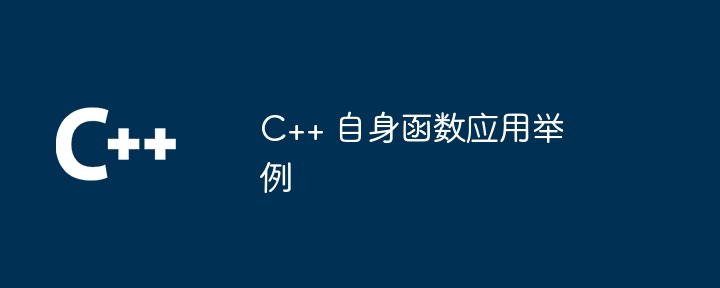++ 自身函数示例:字符串操作:std::string::find 函数查找子串。数值转换:std::stoi 和 std::stof 函数分别将字符串转换为整数和浮点数。容器操作:std::vector::push_back 函数添加元素,std::sort 函数对元素排序。输入/输出:std::cin 和 std::cout 分别从标准输入读取和输出数据。时间操作:std::time 函数获取当前时间戳,std::localtime 函数将其转换为本地时间。

C++ 自身函数应用举例
C++ 提供了丰富的自身函数,用于处理各种数据类型和操作,本文以几个实战案例展示其应用。
1. 字符串操作
立即学习“”;
string::find 函数用于查找字符串中特定子串的位置,例如:
#include <string> int main() { std::string myString = "Hello, world!"; size_t pos = myString.find("world"); if (pos != std::string::npos) { std::cout << "Found "world" at position " << pos << std::endl; } return 0; }
登录后复制
2. 数值转换
std::stoi 函数将字符串转换为整数,std::stof 函数将字符串转换为浮点数,例如:
#include <iostream> #include <string> int main() { std::string myString = "123.45"; int myInt = std::stoi(myString); float myFloat = std::stof(myString); std::cout << "myInt: " << myInt << std::endl; std::cout << "myFloat: " << myFloat << std::endl; return 0; }
登录后复制
3. 容器操作
std::vector::push_back 函数将元素追加到向量末尾,std::sort 函数对容器中的元素进行排序,例如:
#include <iostream> #include <vector> int main() { std::vector<int> myVector; myVector.push_back(1); myVector.push_back(3); myVector.push_back(2); std::sort(myVector.begin(), myVector.end()); for (int element : myVector) { std::cout << element << " "; } std::cout << std::endl; return 0; }
登录后复制
4. 输入/输出
std::cin 函数从标准输入读取数据,std::cout 函数输出数据到标准输出,例如:
#include <iostream> int main() { int number; std::cout << "Enter a number: "; std::cin >> number; std::cout << "You entered: " << number << std::endl; return 0; }
登录后复制
5. 时间操作
std::time 函数返回当前时间自纪元以来经过的秒数,std::localtime 函数将其转换为本地时间,例如:
#include <ctime> #include <iostream> int main() { std::time_t currentTime = std::time(nullptr); std::tm *localTime = std::localtime(¤tTime); std::cout << "Current time: "; std::cout << localTime->tm_hour << ":" << localTime->tm_min << ":" << localTime->tm_sec << std::endl; return 0; }
登录后复制
以上就是C++ 自身函数应用举例的详细内容,更多请关注php中文网其它相关文章!
 微信扫一扫打赏
微信扫一扫打赏
 支付宝扫一扫打赏
支付宝扫一扫打赏

